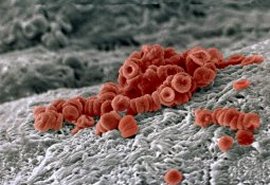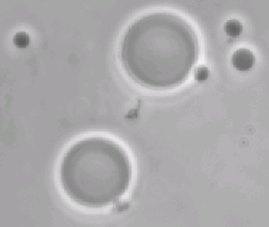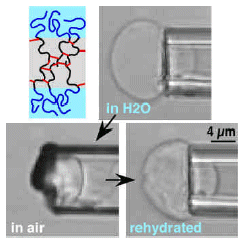|
Researchers are learning to make designer
cells for dehydrated blood supplies and space-age medicines.
by Karen Miller
Red blood cells are
great at carrying oxygen. Unfortunately, that's about all they do.
Let's face it: with a little bit of help, they could be a lot more
useful.
Imagine, for example,
blood cells that could carry all kinds of things--medication as
well as oxygen. Imagine blood that could be dehydrated, and stored
for months or even years at a time. It could be carried by medics
onto a battlefield--or by astronauts into outer space. Imagine blood
that could be used for transfusions with no risk of AIDS or any
other disease.
A group of university
researchers is helping NASA develop an artificial cell that can
do all this and more.
Bioengineers Dan Hammer
and Dennis Discher of the University of Pennsylvania and Frank Bates
of the University of Minnesota have created a special kind of molecule--a
polymer--that forms something very like a cell membrane, and they've
been able to coax these membranes into artificial cells, or polymersomes,
that are stronger and more easily manageable than the real thing.
A polymer is simply
a chain of smaller molecules that have been linked together. The
cellulose in plants and the wool on sheep are natural polymers.
Man-made polymers can be found in everything from nylon stockings
to car parts to furniture stuffing.

Credit: Iowa St. University
Red blood
cells.
|
The polymers used in
polymersomes are larger and heavier than the natural molecules in
cell membranes: They've got a molecular weight of over 3600, compared
to about 750 for phospholipids, the fatty acid molecules used by
cells.
Manmade molecules can
be crafted with an important characteristic, which many naturally
occurring molecules share; they can be engineered to be amphiphilic,
where one end seeks water, and the other end avoids it. In a water-based
solution, such molecules spontaneously arrange themselves into a
double-layer with their hydrophobic (water fearing) tails in the
middle and their hydrophilic (water loving) heads on the outside.
"That was our insight,"
said Hammer. "We realized that there's nothing that prevents a polymer
from forming a bilayer like a phospholipid would."
But polymersomes have
one huge advantage: they can be controlled. By adding in different
molecules, researchers are learning to manipulate their abilities
and make them do things that biological cells just can't manage.
For example, polymersomes
can be made strong. While it's true that the phospholipids in natural
membranes hold together, they don't bond with each other very tightly.
They move around within the cell membrane, and, without the pressure
of a watery environment, they fall apart.

Credit: University of Pennsylvania
Giant,
2-20 mm, polymersomes in phosphate buffered saline – visualized
by phase-contrast microscopy (internal solution of 300
mM sucrose).
|
Polymersomes, on the
other hand, can be designed so that they cling to each other tightly.
Their atoms can bond not only within a single polymer, but also
to the polymers next to them. This is called cross-linking, and
it vastly increases the strength of artificial cells. (It's cross-linking
that stiffens the curls in a beauty-shop permanent enough to keep
the shape of the hair-do.) In fact, between cross-linking and the
increased molecular weight of the polymers, polymersomes are a thousand-fold
stronger than phospholipid cells.
"Probably the main
advantage from NASA's point of view," says Hammer, "is that once
the polymersomes are crosslinked, the cells become durable enough
to be dehydrated into a powder." They can be stored easily, for
a long time, and without taking up much space. In other words, it
would be a perfect way to carry extra blood for medical emergencies
on long distance voyages in outer space.
That, in fact, is the
use that he and his colleagues initially envisioned, says Hammer.
But they quickly realized that the polymersomes could be used for
transporting other things.
Hammer explains: It's
easy to encapsulate many kinds of molecules with polymersomes; such
artificial cells could then be sent throughout the body. Because
their outer membrane consists of molecules that don't interact with
cells, polymersomes are invisible to the immune system. They can
travel unhampered through the bloodstream.
Polymersomes can also
be engineered so that some types of cells do react to them.
Hammer, Discher and colleagues can add to their polymersomes particular
molecules that latch onto the cells they're targeting. Typically,
says Hammer, the polymersomes float through the bloodstream for
about 18 hours before they reach their destination and grab onto
the target cells.

Credit: University of Pennsylvania
This
sequence of microscopic photos shows how a tough crosslinked
polymersome can be dehydrated (for, e.g., easy
storage and transportation) and rehydrated again.
|
The key word is "target."
Doctors using polymersomes wouldn't have to pepper the entire body
with medications. They could be targeted--sent only to the places
they're needed. Arthritis medications, for example, could be sent
only to a patient's swollen fingers, without the risk of causing
reactions elsewhere. Polymersomes could carry cancer-zapping pharmaceuticals
directly to a tumour. They could incorporate imaging agents like
iron oxide particles, which can be detected by magnetic resonance
imaging. If these particles are encapsulated into polymersomes designed
to latch onto cancer cells, they'd be able to locate small tumour.
cells that have migrated through the body.
Polymersomes could
theoretically be designed to carry both the imaging agents that
locate a problem, and the medication that treats it.
Using manmade materials
to produce an artificial cell is "a highly novel concept," says
Hammer. "I think that NASA saw this as a wonderful material, and
they wanted to see how far it could evolve." In some conditions,
he says, polymersomes take on shapes that are very reminiscent of
the ones biological cells take on when, for instance, they're dividing.
And Hammer and his
colleagues are still exploring the possibilities. They're experimenting
with different types of polymers, to see how the capabilities of
artificial cells can be expanded.
The most exciting applications
of polymersomes, believes Hammer, are still to come.
|
